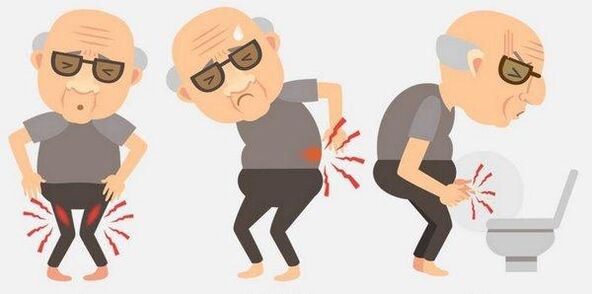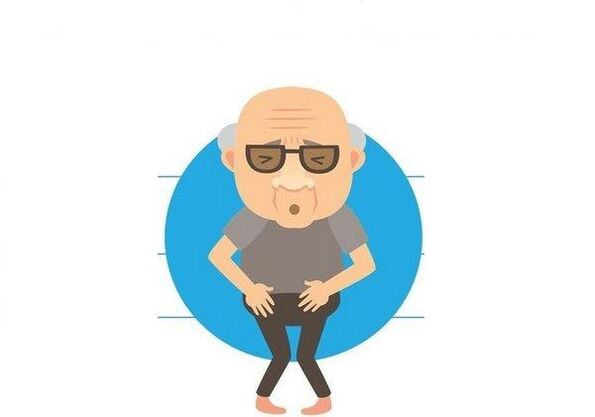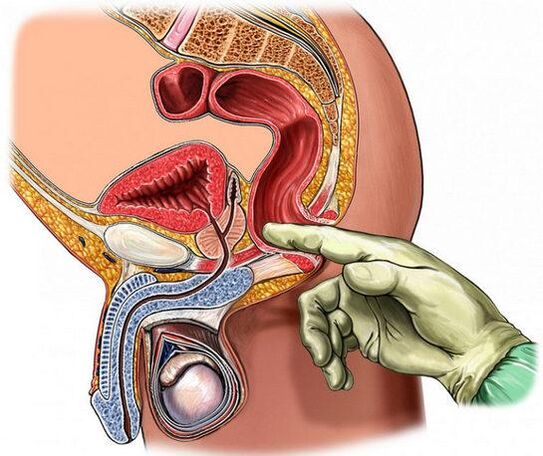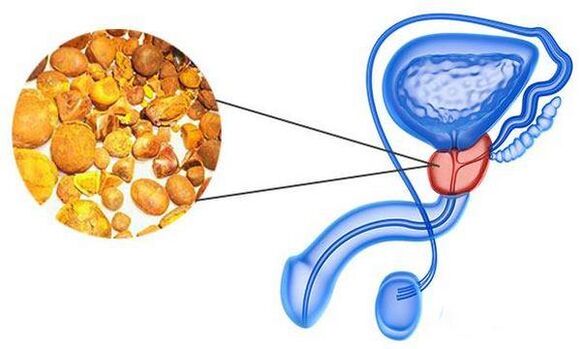Symptoms of prostatitis depend on the form and causes of inflammation of the prostate gland, as well as the presence of simultaneous diseases. Symptoms often crucify, which significantly complicates the diagnosis.

Chronic prostatitis
Chronic prostatitis develops as an independent disease or as a complication of acute form of inflammation. During forgiveness, the symptoms are weak or completely absent, with irritation they become more pronounced. Clinical photography resembles acute prostatitis.
The first symptoms of chronic form of inflammation:
The above signs in the chronic form of prostatitis do not manifest immediately. Initially, this can be a lubricated orgasm, premature spill, then a person must be strained during urination, the pain gradually joins.
In an ultrasound with chronic inflammation, there is a decrease in prostate tissue density, an increased degree of wave reflection. In places, it decreases in the presence of cysts or intensifies in places of exposure to calcins (stones), sclerosis seals (stamping from connective tissue, formed due to recovery processes after acute inflammation). In the late stages of connective tissue and fibrosis tissue, there are more and more. The size of the prostate gland is reduced. During visual diagnosis, it is already difficult to distinguish it from the surrounding fiber.
Acute prostatitis
The acute form of infectious (bacterial) prostatitis is characterized by rapid development. The severity of the symptoms depends on the degree of damage to the gland. With a catarral form (inflammation only affects the canals), a man can only feel little discomfort during the stress of the inguinal region. During the examination of the iron finger, it has grown slightly and almost painless.
Follicular (purulent inflammation of individual gland lors), parenchymal (inflammatory lesions of all prostate tissue) and abscesses (capsules with purulent contents) are manifested by a whole complex of symptoms:

With a parenchymal form of prostatitis, painful cramps and pulsating pain in the rectum make the defect difficult. Small relief occurs only in a lying position with printed feet. Often, prostate inflammation extends to the rectum, then the mucosa begins to be extracted from the anus. Uring on the background of a parenchymal shape can be completely stopped due to severe gland edema.
External signs of acute prostatitis in ultrasound:
With suspicious neoplasms, MRI or CT is described.
Stagnant prostatitis
Prostatitis stagnation (also called bacterial in the absence of infections) can develop in young and elderly men. The main symptoms are similar to chronic infectious inflammation. A distinctive feature is that the discomfort from the urinary system manifests and improves mainly due to long -term sexual abstinence. An irritation can cause violent extension of sexual intercourse, a non -orgasm orgasm (sex without proper emotional coloring). Remote, painful urination (stroller) is usually observed in the morning. However, if the day before was a complete orgasm, there are no cramps.
With this type, prostate is the amount of leukocytes in the secret of the gland does not exceed the rate, there are no pathogenic flora in the third part of the urine.
Prostatitis rider
Knight prostatitis has no specific symptoms. The very presence of stones (calcins) in the gland does not mean automatic development of its inflammation. With physical exercise, background pain can intensify. Migration of stones through canals sometimes provokes the appearance of blood in the urine.
During a prostate ultrasound, calcinates are detected. Due to increased density, they more effectively reflect the waves emitted by the device.
Characteristics of prostatitis manifestation in young and mature

Symptoms of different forms of prostatitis do not depend on a human age category. Young people are actively living sex life, so they often develop an acute form of infectious inflammation with the corresponding signs.
Chronic prostatitis is diagnosed in men several years after the onset of sexual activity. During this time, due to the activity of hidden infections, the prostate structure is violated, its cellular immunity is reduced. Symptoms appear at a time when pathological changes are already irreversible.
Mature men mainly suffer from urination disorders, periodic thick periodic pain and elevation disorders. The prostate slap at this age is exacerbated by stagnant pelvic processes against the backdrop of androgen failure and loss of muscle tone.
When and to whom to contact
Anydo of the above symptoms is the reason for contacting urologist or andrologist (diagnosis of prostatitis in clinical and domestic conditions). Many men avoid going to the doctor due to a negative attitude for examining the prostate with one finger through the anus or trustees (transchectal ultrasound). If the patient categorically refuses these types of studies, the doctor will provide transabdominal ultrasound - when the sensor relies against the lower abdomen. The bladder should be filled (simply drink 350 ml of liquid one hour before the procedure).
Based on the results of the ultrasound, the doctor determines the nature of the prostate tissue lesion surrounding its tissues and the bladder. To identify the cause of inflammation, it is necessary to pass the urine, blood, prostate secret (you need rectal gland massage), in some cases a spermogram.
Which diseases have similar symptoms
Many diseases have prostatin -like symptoms. First of all, it is cystitis (bladder inflammation). It is characterized by a frequent stirring in the toilet, dying in the lower abdomen, pain during urination, mud urine, sometimes with blood. Probably a slight increase in temperature.
Men over 45 years of age, with prostate symptoms, glands and gland cancer are mainly excluded. Inflammation against the backdrop of these pathologies is often a secondary sign. Symptoms of glandular cancer are similar to manifestations of a chronic form of prostatitis: periodic urination disorders that attract pain in the groin. The prostate is painless with a finger study, but dense joints are found in its structure.
Night urination away, a slow flow of urine, a feeling of incomplete bubble emptying, the flow of points from the urethra and severe to the perineum are characteristic of adenoma. The photo is explained by palpation and ultrasound: prostate contours are preserved, the consistency is elastic, the surface is polished, the iron is almost painless.
Disordisms of urinary and pain in the groin can occur with non -infected prostate stones - the calcinates are present, but there is no environment favorable to join the pathogens. Discomfort in the perineum in this case provoke physical activity, spill. With the feeling of a prostate under the fingers, criticism can be felt, the gland's body is dense, tuberous, moderately painful.
Disordishes of urination, characteristic of the chronic stage of the disease, are also characteristic of bladder sphincter sclerosis (obstacles throughout the urethra in the prolonged form of the incision muscles). Pathology is often the result of prolonged prostate. In men under the age of 40, it is rarely diagnosed.
For chronic prostatitis, expanded venous joints (internal hemorrhoids) are often obtained. They can only be found using a special diagnostic tool. Symptoms:
The contours and consistency of the prostate are unchanged. In its secret, pathological changes are missing.

Pain in the area of the anus and perineum occurs with proxy - inflammation of the rectum. A characteristic feature is a strong burning sensation in the anus during and after defecation, giving the penis and claws. There is a stimulus for frequent urination (every 20-30 minutes) followed by Lacus urine. Prozatitis often develops at the same time with prostatitis. In this case, parallel therapy for both diseases is necessary.
Symptoms of prostatitis also manifest with tuberculosis of the gland. In the risk area of a man from 20 to 40 years old. In the early stages of development, the disease is almost asymptomatic. Sometimes, minor pain in the rectum and perineum occur. Urinary violations begin against the backdrop of involvement in the pathological process of the gland parts, communicating the channel that releases the hunger.
With tuberculosis, the purulent cavities form in the prostate body. When they penetrate, the contents are poured into the urethra and released from the penis during defecation. Bacteria that have fallen into the ureter irritate the mucosa of the mucosa, provoke rapid and painful urination. Through the fibers, the pus can spread to the rectum. In this case, there is an increase in temperature, weakness, sweating, weight loss.
cONcluSiON
The prostate gland through the nerve plexus is closely associated with other pelvic organs, whose inflammation gives prostatin -like symptoms. The doctor should distinguish (distinguish) the prostatitis from other diseases and identify the related ones. The patient should not surprise the fact that with symptoms of prostate, the examination is aimed at not only iron but also other organs, in particular, in the rectum. It is important to exclude their participation in the formation of pain and urination disorders, otherwise the treatment will be ineffective.























